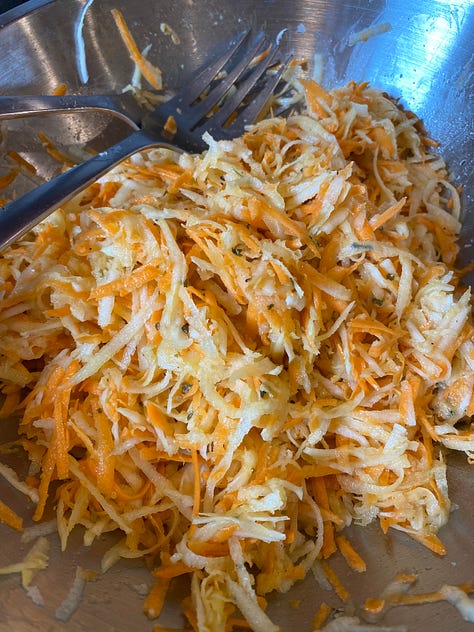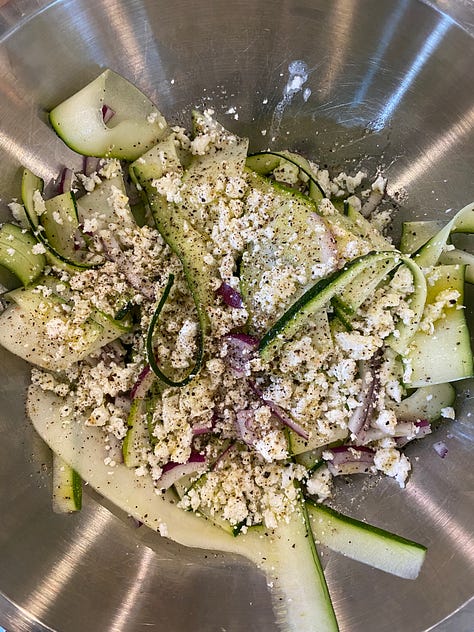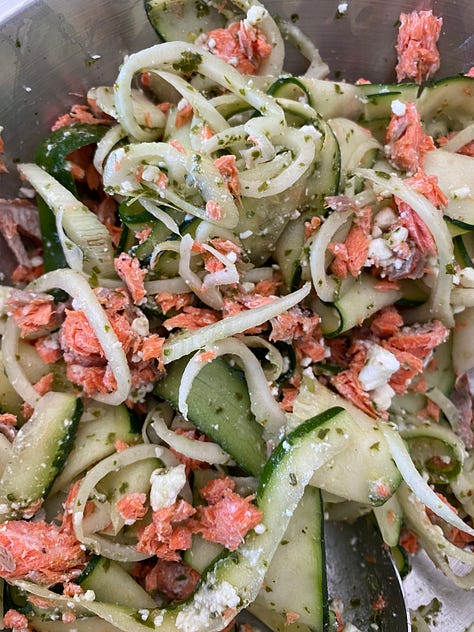Do you serve them as a side or do they make up half the plate? Do you think they really stink or do you think they’re really great? (Is this a dr seuss book???)
Dr. Seuss has taken over our lives in the last several months, you could say that the little one is OBSESSED. We own several, but I make sure to check out one Dr. Seuss book with each monthly library trip, just to keep it fresh. There are only so many dramatic, Oscar-worthy readings of Green Eggs & Ham that I can do in a week, you know. The Lorax is our current fave: not one that I grew up reading a lot, but I love it now — published in 1971, Dr. Seuss delivers a great message about the lessons that giant manufacturers and corporations are currently learning about the environmental effects of late stage capitalism, but in rhyme!
Which actually ties in really nicely to what I’m writing about for you today: vegetables. Where you get them from absolutely changes the benefits that you reap from them. My truncated (believe it or not) soap-box rant on food-sourcing starts now.
Large producers are growing their products in monocrops: the same thing is grown on the same ground, over and over, meaning that the nutrients in the soil are being depleted exponentially with each crop and season. If the health of the soil decreases with each repetition, the nutrients in the food grown on that soil also decrease. Even with “organic” labels, these crops are grown en masse — they aren’t being sprayed with pesticides etc, but they are being manipulated in other ways that don’t do anything for the health of the plant or the soil, making these products less nutritionally beneficial.
When you purchase your produce from small farms and producers, you are sourcing locally and seasonally. Even though many farmers at the farmers market are not certified-organic, they are most likely using organic practices and methods when growing their crops. The process in which a farm gets that certification is lengthy and expensive, something that a lot of small farms just don’t have the resources for. Crop and livestock rotations are easy ways to reinvigorate the health of the soil. Healthier crops = higher nutrient levels. Because of these strategies, you can also be sure that the items you are buying at the farmers market are packed with the nutrients that they are reported to have
Of course, it is essential to be aware that these farmers market products come with a price tag. But so does the doctor’s office. As much as it pains me to feel stretched by my own self-imposed grocery budget (NO THANKS TO STUDENT LOANS), it does pay off in this way. Every little bit counts — making the investment to visit your local market every weekend is worth it to support the health of your own body and the health of your local economy. When we started going, we budgeted a specific amount, I think it was $40, usually brought in cash to avoid awkward interactions with vendors about how they don’t take credit card. (I find that most take credit card, but prefer cash — they take home more this way, so don’t be surprised if they slightly rise the price if you pay with card to make up for credit card fees that they take on.) This made for a good physical demonstration of what $40 could get you at the market each weekend. Over time, this expanded to the majority of our grocery budget.
From my own personal experience, I have seen and reaped the health benefits of sourcing the majority of our food from local farmers. For a period of about 10 years, I struggled with eczema. Grad school brought on a whole new set of stressors, the main one being the impending doom of going out into the world to try and make a living as a musician. Orchestra auditions are insanely competitive and my skin was a wreck. I was wearing gloves at night to keep from scratching myself in my sleep. I was self-conscious about the scabs and lesions on my fingers and arms on a daily basis, but especially on our wedding day in 2018. It was bad, but not bad enough for a doctor to tell me anything other than “use a steroid cream on it and lower your stress levels.”
Come 2016, I’d established myself as a strong freelance violinist in the Indianapolis area, actually making that living as a musician thing work. Still very stressful because freelancing is not for the weak of heart. Or mind. Or body. Or anything. Cooking had taken an almost therapeutic role in my life to help distract me from putting too much perfectionistic pressure on myself. So to go beyond just making recipe after recipe, I took a dive into reading food writing and journalism. Many of these books and articles are focused on health, nutrition, and how the food industry does little to support us in those areas. I have talked about this book before, but I really cannot stress enough how it changed my life: The Omnivore’s Dilemma by Michael Pollan. It helped me learn all of the information that I have written about above, and most importantly, it got me to start sourcing as much of my food locally as I could.
By the beginning of 2019, my eczema was gone, even after making this huge stressful decision to uproot my career and start my own business as a personal chef. It took years, but it went away and never came back.
So now we get to the meat, er, core of today’s issue. Vegetables. It’s pretty simple: we all need to be eating more of them. Along with fruit, they provide the spectrum of micronutrients and phytochemicals that bring our bodies, guts, and minds to a healthful state. First, let’s review a quick summary of what each color brings to the table:
RED 🍎🍅🌶️🍒🍉
vitamins + minerals: A, C, K, potassium
phytochemicals: anthocyanins, beta pains, carotenoids, ellagic acid, ellagitannins, flavones, lycopene, phloretin, quercetin
benefits: anti-carcinogenic, anti-inflammatory, antioxidants, immune function, liver health
ORANGE 🍊🥕🥭🍠🎃
vitamins + minerals: A, C, E, K, potassium, calcium, manganese
phytochemicals: alpha-carotene, beta-carotene, beta-cryptoxanthin, carotenoids, curcuminoids
benefits: antioxidants for fat-soluble tissues, blood pressure control, dental health, endocrine modulation, eye health, fertility support, immune function, skin health
YELLOW 🍌🌽🍍🍋
vitamins + minerals: A, C, K, potassium
phytochemicals: gingerol, lutein, nobiletin, prebiotic fibers, rutin, zeaxanthin
benefits: gastric motility and regulation, glycemic impact, support balanced gut microbiome
GREEN 🥦🥝🥬🫛🥑
vitamins + minerals: A, B, C, E, K, iron, calcium, folate (B9), manganese, magnesium, zinc
phytochemicals: oleuropein, phytosterols, sulforaphane, tannins, theaflavins, tyrosol, vitexin
benefits: antioxidants, blood vessel support, blood sugar regulation, bone health healthy circulation and methylation, immune support, skin health
BLUE/PURPLE 🫐🍆🍇
vitamins + minerals: B, C, K potassium
phytochemicals: anthocyanins, flavonoids, phenolic acids, proanthocyanidins, pterostilbene, resveratrol, stilbenes
benefits: antioxidants, cognitive support, heart health, mood balance, liver health, play role in health of neurons
Knowing that each color brings something valuable to the table, it becomes more motivating to “eat the 🌈”, as they say. With this issue, I am providing a framework to help diversify the way in which we eat our vegetables. And now I’ll bring it back to the title: Vegetables — Do You Like Them Hot or Cold?
Honestly the answer should be both. I can have a cold vegetable salad or roasted vegetables any time of year. Of course, it’s less time-consuming in the summer to have them cold (and who wants to turn on the oven anyway? thank god we’re just about done with that time of year), but if you’re fast, it’s really not that much time that you’ve saved if you count out the roasting time.
QUICK PICKLES (for a low-effort, easy garnish)
pickled red onion
thinly sliced red onion (enough to fill 12oz ball jar, or larger if needed)
water
white vinegar
white sugar
kosher salt
pickled red cabbage
thinly sliced red cabbage (enough to fill 12oz ball jar or larger if needed)
water
white vinegar / apple cider vinegar
white sugar
kosher salt
pickled carrots + daikon
shredded carrots and daikon radish (peeled and shredded on box grater; enough to fill 12oz ball jar, or larger if needed)
rice vinegar
white sugar
kosher salt
optional: sesame oil (min. 1 tsp per 12oz jar before shaking)
The method for the above recipes is similar enough to put it all down here. Fill your jar with your vegetable of choice. Pour in enough water to come up to the halfway mark. Fill the remainder with the vinegar of choice, until vegetables are submerged. Add salt and sugar, and shake the jar until these are dissolved.
If you’re needing to speed up the pickling process a bit, make sure that your water is just off the boil. If time is not an issue, feel free to use cold water and just put your jar in the fridge for later.
Sometimes these are great straightaway, sometimes they need time to sit and pickle. Each end of the spectrum has something to offer — it’s up to you how much pickling you like. All that matters is that it’s quick. And they last forever in your fridge.
COLD SALADS (no 🥬 allowed)
cucumber + salad turnip salad
1 english cucumber (thinly sliced and cut into half moons)
3 medium salad turnips (peeled, thinly sliced, and cut into half moons)
drizzle EVOO
drizzle sweet white vinegar (I like the Carandini Bianca)
freshly cracked himalayan pink salt + black pepper, to taste
carrot + kohlrabi salad
4-5 carrots (peeled and shredded on large holes of box grater)
1 medium kohlrabi (peeled and shredded on large holes of box grater)
vinaigrette of choice (examples):
EVOO + red wine vinegar + dijon mustard + honey
sesame oil + rice vinegar + splash soy sauce + honey
zucchini ribbon + fennel + feta salad
2 medium zucchini (ends removed, cut into thin ribbons with vegetable peeler, as much as can be removed with the skin and without seeds; cut up remainder into small cubes and freeze)
1 fennel bulb (thinly sliced)
½ cup crumbled feta (add more if desired)
drizzle EVOO
drizzle sweet white vinegar
freshly cracked himalayan pink salt + black pepper, to taste
Place the ingredients for your cold vegetable salad of choice in a large mixing bowl and combine until each piece is evenly coated with the dressing.
BRAISED GREENS (because good fats are good for your 🧠)
braised dark leafy greens
1 bunch collard greens (stems removed, leaves finely chopped)
1 bunch lacinato kale (stems removed, leaves finely chopped)
optional greens:
leeks (dark green parts, finely chopped)
celery leaves (finely chopped)
2T salted butter
2T EVOO (extra-virgin olive oil)
6 garlic cloves (peeled and smashed)
1 cup chicken broth / bone broth
salt + pepper, to taste
optional:
1 ½ tsp apple cider vinegar
2 tsp dijon mustard
In a heavy-bottomed saucepan, heat your butter and EVOO over medium heat until the butter melts and the fats have combined and start bubbling. Add the greens and mix together until they are coated evenly with the fats. Let heat through and release some moisture, lower the heat to medium-low, cover, and cook for 10 minutes, stirring occasionally. Add the garlic cloves and lower the heat to low. Cook 15-20 more minutes, stirring occasionally, making sure that the greens are not browning. Add the broth and cook uncovered until the liquid has evaporated. The greens should be much duller in color and very soft. If using ACV and mustard, add these at the very end. Adjust salt + pepper seasoning as needed. Sometimes a quick drizzle of honey can help balance any extra saltiness.
ROASTED (classic, not basic)
my favorites: sweet potatoes, beets, delicata squash
my method:
sweet potatoes and beets: peel and slice into ¼” rounds or half moons
delicata squash: cut in half lengthwise, remove seeds, cut into ½” slices
preheat oven to 400F
in a mixing bowl, add your vegetable of choice
drizzle heavily with EVOO / avocado oil / chicken drippings
season with salt + pepper
additional herbs + spices:
smoked paprika + garlic powder
herbes de provence + garlic powder
za’atar spice blend
cumin + oregano + smoked paprika + garlic powder
mix until each piece is evenly coated, then place in a single layer on a prepared baking sheet (use parchment paper or a silicone baking mat)
place your baking sheet in the oven and roast for ~20 minutes, or until fork-tender (like buttah) and lightly browned on the bottom






I know this was a lengthy one this week, but well worth it, right? So many options for simple vegetable preparations. I saw this issue as an opportunity for you to get to know me and what I stand for, plus lots of good home cooking stuff for the world of vegetables. Please let me know if you’ve learned anything new from it or have any other thoughts to share. Comment below!
From the bottom of my heart, thank you for being here.
❤️ Sarah






